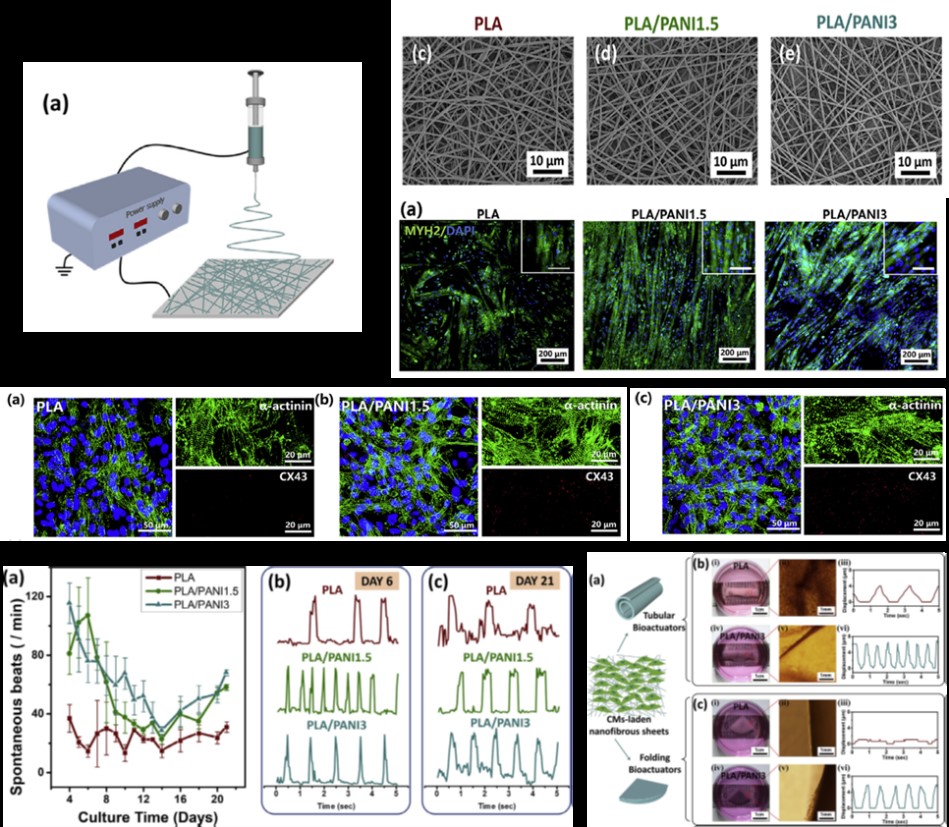|
电纺丝导电纳米纤维心肌组织工程和三维生物致动器的应用
Acta Biomaterialia2017, 59, 68–81 在过去的二十年里,心脏疾病和心力衰竭影响了全世界的很多病人,并且心肌梗塞是世界范围内的主要死亡原因。心肌组织损伤再生的主要障碍是心肌再生能力差,梗死部位的瘢痕形成。在心肌组织工程中主要的研究方向,通过生物材料制成工程心脏组织结构,以及结合心肌细胞制成心肌制动器。PLA/PANI含量,纤维直径相同的PLA/PANI导电纳米纤维毡。PLA/PANI纳米纤维板具有导电性和类似细胞外基质的纳米结构,具有良好的生物相容性,对于H9c2细胞的肌管数目和成熟程度有促进作用。 西安交通大学的郭保林团队研究制备了不同PANI含量,纤维直径相同的PLA/PANI导电纳米纤维毡。PLA/PANI纳米纤维板随着PANI含量的增加能促进心肌细胞铺展,排列和细胞间相互作用。担载心肌细胞的PLA / PANI3导电纳米纤维板可以制成管状和折叠状三维生物致动器 。与纯PLA三维制动器相比具有更高的自发跳动频率和位移。因此,这些具有导电性和细胞外基质的纳米级导电纳米纤维板在心脏组织工程和基于心肌细胞的三维生物致动器中表现出了良好的前景。 Cardiac diseases and heart failure are effecting numerous patients around the world in the past two decades, and myocardial infarction is the major cause of death worldwide. The regeneration of damaged heart tissue is severely limited by the poor regenerative potential of myocardium and the scar formation around the infarction sites. Tissue engineering is a promising approach for cardiac regeneration by combining biomaterials and cardiomyocytes (CMs) to generate engineered cardiac tissue constructs, and also has potential application for fabricating CMs-based bioactuators. The Guo Baolin team of Xi’an Jiaotong University researched and prepared PLA/PANI conductive nanofiber sheets with different PANI contents and the same fiber diameters. These PLA/PANI conductive nanofibrous sheets exhibited good cell viability and promoting effect on differentiation of H9c2 cardiomyoblasts in terms of maturation index and fusion index. Moreover, PLA/PANI nanofibrous sheets enhanced the cell-cell interaction, maturation and spontaneous beating of primary cardiomyocytes. Furthermore, the cardiomyocytes-laden PLA/PANI conductive nanofibrous sheets can form 3D bioactuators with tubular and folding shapes, and spontaneously beat with much higher frequency and displacement than that on cardiomyocytes-laden PLA nanofibrous sheets. Therefore, these PLA/PANI conductive nanofibrous sheets with conductivity and extracellular matrix like nanostructure demonstrated promising potential in cardiac tissue engineering and cardiomyocytes-based 3D bioactuators. (张守燕)
|
